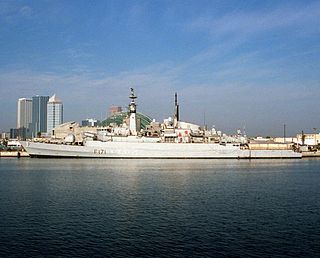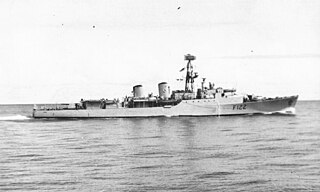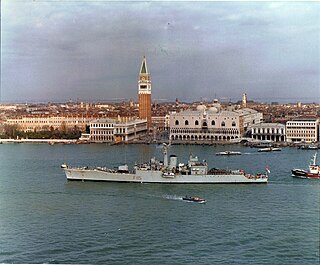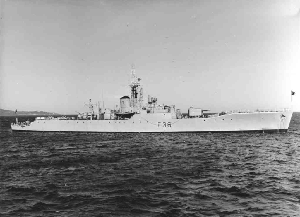
The Type 21 frigate, or Amazon-class frigate, was a British Royal Navy general-purpose escort that was designed in the late 1960s, built in the 1970s and served throughout the 1980s into the 1990s.

HMS Active was a Type 21-class frigate of the Royal Navy. Built by Vosper Thornycroft, Southampton, England, she was completed with Exocet launchers in 'B' position, the first of the class to be so fitted.

HMS Lynx (F27), was a Leopard-class Type 41 anti aircraft frigate of the British Royal Navy, named after the lynx.

HMS Dido was a Royal Navy (RN) Leander-class frigate. Entering service in 1961, Dido was involved in the Indonesia–Malaysia confrontation, served with NATO's Standing Naval Force Atlantic on several occasions, and was one of the frigates used for the filming of the drama series Warship.

HMS Danae was a Leander-class frigate of the Royal Navy. She was, like the rest of the class, named after a figure of mythology. Danae was built by Devonport Dockyard. She was launched on 31 October 1965 and commissioned on 10 October 1967.

HMS Gurkha (F122) was a Tribal-class frigate of the Royal Navy. She was named after an ethnic group located in Nepal, and who continue to serve in the British Army. She was sold to the Indonesian Navy in 1984 and renamed KRI Wilhelmus Zakarias Yohannes (332).

HMS Zulu (F124) was a Tribal-class frigate of the Royal Navy in service from 1964 to 1984. She was the third ship bearing the name of HMS Zulu, having been named after an ethnic group located primarily in KwaZulu-Natal Province, South Africa. Zulu was built by Alexander Stephen and Sons, of Govan. She was launched on 3 July 1962 and commissioned on 17 April 1964.

HMS Yarmouth was the first modified Type 12 frigate of the Rothesay class to enter service with the Royal Navy.

HMS Torquay was a Type 12 Whitby-class frigate of the British Royal Navy. They were the first frigates to have the "V" form hull. This evolutionary design made it possible to be driven in head sea without the usual slamming which occurs with conventional destroyers of the time. Each frigate cost 3.5 million pounds and the first ship completed was Torquay in May 1956.

HMS Brighton was a Rothesay or Type 12I class anti-submarine frigate of the Royal Navy.

HMS Berwick was a Rothesay- or Type 12I-class anti-submarine frigate of the British Royal Navy. She was built by Harland & Wolff and launched on 15 December 1959.

HMS Whitby was a Whitby-class or Type 12 anti-submarine frigate of the Royal Navy of the United Kingdom built by Cammell Laird and Co Ltd, Birkenhead. She was launched on 2 July 1954 and commissioned on 10 July 1956.
HMS Leopard (F14), was a Leopard-class Type 41 anti aircraft frigate of the British Royal Navy, named after the leopard.
Dat Assawari was a frigate operated by the Libyan Navy. The ship was built by VT Group in the United Kingdom. It was ordered in February 1968 and delivered in 1973. The ship's design, the Vosper Mk 7 is a modified version of the Alvand-class frigate built for the Iranian Navy. The ship had an extensive refit in Italy by CNR Riva Trigoso 1979–1980 when new sensors and missiles were installed. During the refit, the ship was mined by French commandos from SDECE. The vessel returned to service in 1983, but returned to Italy for repairs in 1984–1985 and 1989–1990. The frigate was reportedly scrapped in the late 1990s.

HNLMS Van Speijk (F802) was a frigate of the Van Speijk class. The ship was in service with the Royal Netherlands Navy from 1967 to 1986. The ship's radio call sign was "PAVA". She was sold to the Indonesian Navy where the ship was renamed KRI Slamet Riyadi (352). The ship was decommissioned in 2019.

KRI Oswald Siahaan (354) is an Ahmad Yani-class frigate operated by the Indonesian Navy. Prior to her service in the Indonesian Navy, she served in the Royal Netherlands Navy as Van Speijk-class frigateHNLMS Van Nes (F805).

HNLMS Van Galen (F803) was a frigate of the Van Speijk class. The ship was in service with the Royal Netherlands Navy from 1967 to 1987. The ship's radio call sign was "PAVB". She was sold to the Indonesian Navy where the ship was renamed KRI Yos Sudarso (353).

HNLMS Evertsen (F815) was a frigate of the Van Speijk class. The ship was in service with the Royal Netherlands Navy from 1967 to 1989. The ship's radio call sign was "PAVG". She was sold to the Indonesian Navy where the ship was renamed KRI Abdul Halim Perdanakusuma (355).

HNLMS Isaac Sweers (F814) is a frigate of the Van Speijk class. The ship was in service with the Royal Netherlands Navy from 1968 to 1990. The ship's radio call sign was "PAVF". She was sold to the Indonesian Navy where the ship was renamed KRI Karel Satsuitubun (356).

HNLMS Tjerk Hiddes (F804) was a frigate of the Van Speijk class. The ship was in service with the Royal Netherlands Navy from 1967 to 1986. The ship's radio call sign was "PAVC". She was sold to the Indonesian Navy where the ship was renamed KRI Ahmad Yani (351).




















